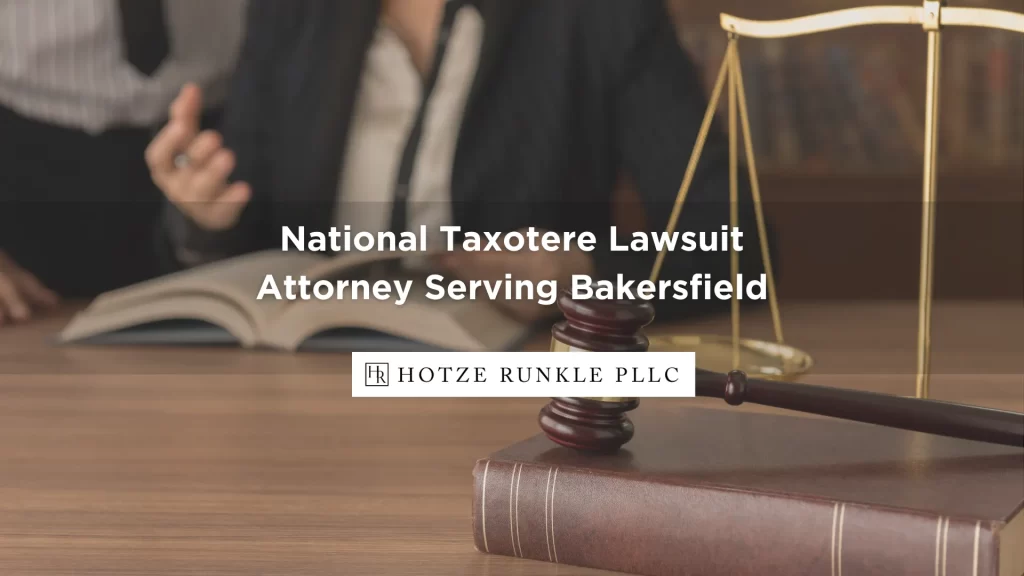
Did you take the drug Taxotere to treat your cancer? Did you end up with adverse side effects, such as excessive eye-watering and Canalicular Stenosis? If so, you might be entitled to financial compensation from the manufacturer.
At Hotze Runkle PLLC, our legal team has experience taking on large companies and holding them accountable for their actions. They failed to provide a safe drug for patients, and you suffered as a result. You deserve the chance to recover the compensation you need to treat your condition.
We understand the devastation of trusting a drug that ended up causing you harm. Sanofi-Aventis manufactured and sold Taxotere for the treatment of cancer without disclosing certain risks. Their negligence led to debilitating symptoms in cancer patients around the country. They should take responsibility for what they’ve done and provide the financial means for injured victims to afford the medical treatment and associated costs they needed because of the drug’s side effects.
Canalicular Stenosis is an irreversible condition of the canaliculus, a structure responsible for funneling tears into the nasal cavity from the tear duct. The symptoms can range from mild to severe. Some patients report adverse effects from Taxotere that interfere with their daily life. They can’t perform routine tasks, such as driving or cleaning the house. This disease and its symptoms are a significant burden in a person’s life and can cause a great deal of stress.
You shouldn’t continue to suffer because of the pharmaceutical company’s misconduct. The Bakersfield Taxotere Canalicular Stenosis attorneys of Hotze Runkle PLLC might be able to represent you in a lawsuit and pursue the compensation and justice you deserve.
What Is Canalicular Stenosis?
Canalicular Stenosis is a permanent condition of the eye that results from chronic inflammation of the canaliculus. The canaliculus is a channel-like structure that drains tears from the tear duct to the nasal cavity. Under normal circumstances, a person’s tears spread across the surface of the eye and drain into tiny holes at the corners. Then, the canaliculus allows them to drain into the nasal cavity.
If the canaliculus becomes inflamed, blockages start to form. These obstructions worsen with chronic inflammation and infections. Eventually, tears can’t flow through the structure and build up on the eye’s surface. Epiphora, eye-watering, is a common symptom of Canalicular Stenosis due to the ongoing inflammation of the canaliculus.
Although watery eyes might not seem like a big issue, they can become a debilitating problem. Some people with epiphora can’t function without someone’s assistance. They might require help dressing or grooming. Others can’t return to their job or care for their family. It’s a traumatic experience for anyone to go through and could significantly diminish their quality of life.
Medical researchers studying the effect of Taxotere on patients discovered a possible link between tears and secretions from the chemo drug. They noted that the secretions come in direct contact with many fluids while traveling through the body. One particular bodily fluid is the patient’s tears. The interaction between tears and Taxotere somehow causes inflammation of the canaliculus, resulting in Canalicular Stenosis.
Common symptoms of this medical condition are:
- Central vision loss
- Clouded eye lens
- Eye infections
- Sensitivity to light
- Excessive watery eyes
- Blurry vision
- Dry eyes
- Eyelid swelling
If you’re experiencing any of these symptoms or other unusual side effects while treating cancer with Taxotere, you should notify your oncologist immediately. It might be best to switch to a different chemo drug to prevent your condition from worsening. You should also see an ophthalmologist and determine if there are treatment options to manage your symptoms.
Why Does Taxotere Cause Canalicular Stenosis?
Just because you’re taking Taxotere doesn’t necessarily mean you will develop Canalicular Stenosis. Researchers found a link between the drug and this condition, but that doesn’t mean everyone who takes Taxotere will experience these symptoms.
Canalicular Stenosis starts to develop when ongoing canaliculus inflammation and chronic infections prevent the proper flow of tears. Obstructions can form and become so severe that the canaliculus begins to close. Once that happens, reversing the effects isn’t possible.
After performing various studies, medical researchers discovered that the reaction between the Taxotere secretions and tears results in an inflamed canaliculus. That’s when excessive eye-watering starts.
Without immediate and adequate medical care, the patient experiences additional symptoms of Canalicular Stenosis. If one or both canaliculi in the eye close partially or entirely, a doctor can’t do anything to open them back up again. This becomes a lifelong permanent issue.
How to Manage Canalicular Stenosis Symptoms
Two surgeries exist that could alleviate your symptoms and prevent the medical condition from progressing further. Unfortunately, neither of them can cure you of your Canalicular Stenosis. It’s irreversible once it develops.
The first option is dacryocystorhinostomy (DCR). During this procedure, the surgeon makes a small incision between your eye and nose and uses existing structures beneath to create a new channel that replaces the damaged canaliculus. They might even place a stent over the passageway to facilitate the proper flow of tears.
Unfortunately, if the damage is so severe that the doctor can’t use existing structures to create a new tunnel, the patient won’t qualify for DCR. Instead, the surgeon might have to perform conjunctivodacryocystorhinostomy (CDCR). In this procedure, they insert a small glass tube called a Jones tube over the obstructed canaliculus, so tears bypass the damaged passageway and use the new one instead.
Both surgeries are invasive and can lead to multiple complications. It’s a risk to undergo any type of medical procedure, and you might not be a candidate for either. The most common risks associated with DCR and CDCR are:
- Abnormally fused tissue
- Uncontrollable hemorrhaging
- Chronic eye infections
- Nerve and tissue damage
- Sinusitis
- Blindness
- Permanent facial scars
- Migrating or displaced Jones tube or stent
Your ophthalmologist will evaluate your condition and inform you of your treatment options. In the early stages, you might be able to alleviate some symptoms with eye drops or a topical ointment. It depends on how far the Canalicular Stenosis progressed before you began seeking treatment.
You Can Continue Chemotherapy While Treating Canalicular Stenosis
If you’re currently treating your cancer with Taxotere chemotherapy, inform your oncologist of your symptoms so you can start using a different drug. You can continue your chemo regimen while also managing your symptoms of Canalicular Stenosis.
Your doctor might decide to insert a temporary stent over your damaged canaliculus until you finish chemo. It could keep the structure open, so your tears flow correctly, and you don’t experience any excessive eye-watering. About six to eight weeks after completing your cancer treatment, the doctor would remove the stent.
How to Hold the Taxotere Manufacturer Liable
Sanofi-Aventis created Taxotere to treat different types of cancer, such as:
- Stomach cancer
- Breast cancer
- Head and neck cancer
- Lung cancer
- Prostate cancer
It works by attacking and shrinking cancer cells to stop them from spreading throughout the patient’s body. The chemo drug is available once a week, once every other week, or once every three weeks. The regimen choice does not seem to affect whether someone develops Canalicular Stenosis. You could get it whether you take Taxotere once a week or once every three weeks.
For years, doctors had no idea about certain risks their patients could face with Taxotere chemo. The patients didn’t know either. They could have chosen a different drug if they knew about the potential of developing Canalicular Stenosis. However, the warning labels didn’t include any of those symptoms. You could file a lawsuit against Sanofi for their failure to adequately warn the public of the dangers they could face while taking Taxotere.
Various losses are eligible for compensation in a Taxotere case, whether you choose to file a lawsuit or insurance claim. The losses you could pursue are:
 Past and future medical bills
Past and future medical bills- Disfigurement or physical impairment
- Personal property damage
- Lost wages
- Lost earning capacity
- Emotional distress
- Pain and suffering
- Lost enjoyment of life
If you want to sue someone for compensation, you must follow a strict timeframe called a statute of limitations. California has a two-year statute of limitations for cases like this. That means you have two years from the date of your injury to file suit, or you could lose your opportunity to hold the drug company liable for their misconduct in court.
Find Out if You’re Entitled to Compensation from the Drug Company
At Hotze Runkle PLLC, our Bakersfield Taxotere Canalicular Stenosis attorneys know how to handle a case against large companies like Sanofi-Aventis effectively. We’re not afraid to battle their insurance company or take them to court. We have the experience, knowledge, and resources to seek the maximum compensation possible so you can heal your injuries and move forward with your life.
We take cases on contingency, so you don’t have to worry about paying upfront fees or costs. We care about Bakersfield residents and want you to have the opportunity to face the manufacturer and hold them accountable for their negligence.
If you took Taxotere to treat breast cancer or another type of cancer and want to learn about your legal options, contact us today. You can take our case evaluation quiz to find out if you’re eligible to file a lawsuit against Sanofi.
 Past and future medical bills
Past and future medical bills